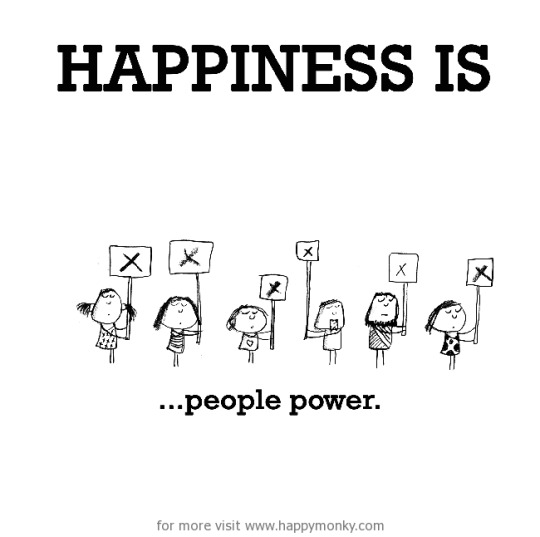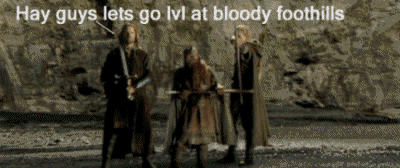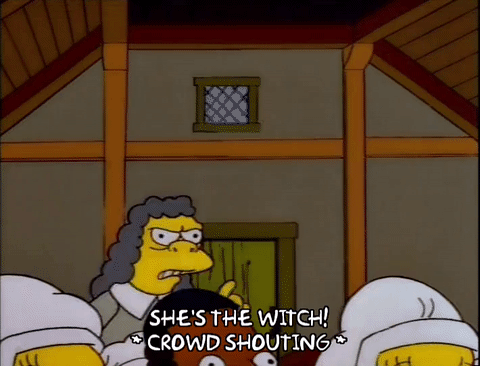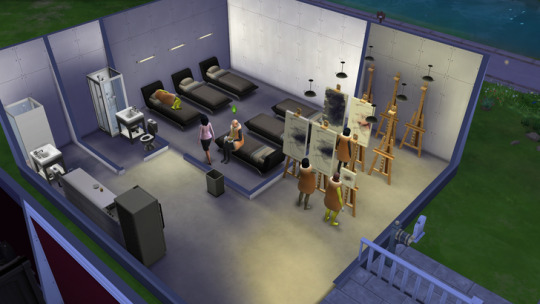#source: The Community Brings THE SIMS MEDIEVAL to The Sims 4
Quote
Fuck you AND your turnips.
FakeGamerGirl
3 notes
·
View notes
Photo

Catholic Physics - Reflections of a Catholic Scientist - Part 101 - Truth Cannot Contradict Truth - Part 2
With Images:
https://www.linkedin.com/pulse/catholic-physics-reflections-scientist-part-101-truth-harold-baines-1/?published=t
SECTION 4: Science “versus” the Church?
“Extinguished theologians lie about the cradle of every science as the strangled snakes beside that of Hercules; and history records that whenever science and orthodoxy have been fairly opposed, the latter has been forced to retire from the lists, bleeding and crushed if not annihilated; scotched, if not slain.” ― Thomas Henry Huxley, “Lay Sermons, Addresses, and Reviews”
Trial of Galileo (Wellcome file) from Wikimedia Commons (Caption for linked image)
As the quote above suggests, atheists have used the Catholic Church as a whipping-boy, have cast it as opposed to science and a persecutor of those who propose novel scientific ideas that disagree with its dogma. The two cases cited most frequently by these atheists are Galileo and Giordano Bruno. As George Sim Johnston puts it:
“The Galileo affair is the one stock argument used to show that science and Catholic dogma are antagonistic. While Galileo’s eventual condemnation was certainly unjust, a close look at the facts puts to rout almost every aspect of the reigning Galileo legend.” – George Sim Johnston, “The Galileo Affair“
Summarizing his arguments, one can say that both Galileo and some Church officials were at fault, but it was a different time with different concerns – high officials in the Church, initially sympathetic to Galileo, were defending orthodoxy against the onslaught of the Reformation.
Galileo was condemned not for his advocacy of the Copernican theory per se, but for his advocacy that Scripture was to be interpreted loosely (even though the same had been done by St. Augustine). And his science was wrong–circular orbits for the planets and his theory of tides. All this is dealt with at greater length in the article linked above. Nevertheless, this one piece of history has been the cannon used in the war of materialists against the Church to support their perceived conflict between the Church and Science.
In 1979 Pope St. John Paul II asked the Pontifical Academy of Sciences to make an in-depth study of the affair. Commenting on their report in 1992, he said, as an apology, explaining what had happened:
“Thanks to his intuition as a brilliant physicist and by relying on different arguments, Galileo, who practically invented the experimental method, understood why only the sun could function as the centre of the world, as it was then known, that is to say, as a planetary system. The error of the theologians of the time, when they maintained the centrality of the Earth, was to think that our understanding of the physical world’s structure was, in some way, imposed by the literal sense of Sacred Scripture….”
–Pope St. John Paul II, “Address to Pontifical Academy of Sciences”, as quoted in L’Osservatore Romano N. 44 (1264) – November 4, 1992
Liberal news media made much of this apology, but it was only recognizing in a formal way earlier actions of the Church: removing Galileo’s book from the index, setting up a Vatican Observatory. Pope St. John Paul II was setting the affair in a historical context. What was critically important in his apology was his affirmation that science and the Church both have domains of truth, domains which do not contradict each other – as in his address on evolution, “Truth cannot contradict Truth.”
The trial of Giordano Bruno (1548-1600) has been used as another example that the Church is opposed to science. Bruno proposed a cosmology that was surprisingly modern: an infinite universe, stars very far away and a non-geocentric cosmology. However, the cosmology was founded on a mystical basis, not on science. In 1600 Bruno was burned at the stake for heresy. As argued in the Catholic Encyclopedia on Bruno, his proposed cosmology did not enter into the charges:
“Bruno was not condemned for his defence [sic] of the Copernican system of astronomy, nor for his doctrine of the plurality of inhabited worlds, but for his theological errors, among which were the following: that Christ was not God but merely an unusually skillful magician, that the Holy Ghost is the soul of the world, that the Devil will be saved, etc.” —Giordano Bruno, The Catholic Encyclopedia
Some historians do argue that Bruno’s cosmological teachings played a part in his conviction for heresy. A good discussion of both sides of this controversy is given in the Wikipedia article on Bruno.
4.2 VITALISM AND DARWIN
That there is (or has been) a cold war between science and the Church should be surprising, if we acknowledge that that science grew in the soil of Medieval Christendom. In the sixteenth and seventeenth centuries those great men who laid the foundations of science —Galileo, Newton, Pascal — believed that the order of the universe was prescribed by God. Nevertheless, by the nineteenth century, as the domain of science spread to that which had been considered wrought only by the Divine — life and the chemistry of life — it seemed to many that there was no need for a God to make and sustain creation.
In the early nineteenth century the theory of “Vitalism” held sway. According to this theory there was a fundamental difference between organic compounds — compounds from biological sources — and inorganic compounds: living things were governed by different principles than inanimate matter and were endowed with a life (vital) force extending to their substance. The synthesis of urea and oxalic acid by Wohler in the early nineteenth century and the later conversion of carbon disulfide to acetic acid by Kobe convinced most scientists that chemistry was chemistry, with one set of principles for both organic and inorganic compounds.
The quote given at the beginning of this section was from an early champion of Darwin’s theory of evolution, the biologist Thomas Huxley, known as “Darwin’s Bulldog,” He had many debates with clerics, the most notable of which was with Samuel Wilberforce, Bishop of Oxford, an account of which is given in the linked material. More is said about the Church’s position on evolution below, but very briefly it can be said that the Church does not deny evolution as a scientific explanation for the diversity of species, but it does emphasize that there are different models for how evolution occurs, not only that of Darwin’s “Survival of the Fittest.”
4.3 POPE ST. JOHN PAUL II’S RAPPROCHEMENT WITH SCIENCE
“Science can purify religion from error and superstition; religion can purify science from idolatry and false absolutes. Each can draw the other into a wider world, a world in which both can flourish.” – Pope St. John Paul II, Letter to Rev. George Coyne,S.J., Director of the Vatican Observatory.
Among the many posts and articles on the canonization of Pope St. John Paul II, there were only a few comments about his efforts to effect a rapprochement between the Church and science. The term “rapprochement” has been chosen with care: “an establishment or resumption of harmonious relations” (Oxford English Dictionary). The term is applied to peace treaties after a state of war, and although the Catholic Church has not declared war on science, there are those scientists who do think there is such a war, and there are those advocates of scientism–that science explains all we need to know about the world – who have declared war on the Church.
There are three ways in which Pope St. John Paul II tried to bring about this rapprochement:
Clearing up the Galileo affair;
Making the position of the Church clear, consistent with both dogma and science;
Setting up conferences on how Divine Intervention might be manifested in ways consistent with scientific theories.
The first has been discussed above; the second is discussed in Essay n; the third is discussed below.
In 1987 Pope St. John Paul II instituted the first of a series of conferences, held at the Papal Summer Residence, Castel-gandalfo, bringing together scientists, philosophers and theologians. Not all of these were Catholic and, indeed, a few were not even theists, as the term is commonly understood.
He addressed the conferees at this first meeting (“Our Knowledge of God and Nature: Physics, Philosophy and Theology”) in a letter to George Coyne, SJ, Director of the Vatican Observatory. (The reader should go to the link above for that letter, to get the full import of his thoughts on science and the Church.) He stressed first, as in the quote at the beginning of this post, the contributions science could make to the Church and the Church to sciences. His comments show a sophisticated knowledge of frontier research in physics and biology:
“The unity we perceive in creation on the basis of our faith in Jesus Christ as Lord of the universe…seems to be reflected and even reinforced in what contemporary science is revealing to us….Contemporary physics forms a striking example. The quest for unification of all four fundamental physical forces–gravitation, electromagnetism, the strong and weak nuclear interactions–has met with increasing success….In the life sciences, too, something similar has happened. Molecular biologists have probed the structure of living material…(and) have discovered that the same underlying constituents (genes and proteins coded by genes) serve in the make-up of all living organisms on earth.” — Pope St. John Paul II, Letter to Rev. George Coyne, Director of Vatican Observatory
.Although he argued that science and theology could, and should, mutually enrich the other, he did not think they should be united as one discipline:
“By encouraging openness between the Church and the scientific communities, we are not envisioning a disciplinary unity between theology and science like that which exists within a given scientific field or within theology proper…. The Church does not propose that science should become religion or religion science… To be more specific, both religion and science must preserve their autonomy and their distinctiveness…. Christianity possesses the source of its justification within itself and does not expect science to constitute its primary apologetic [emphasis added]. Science must bear witness to its own worth…. neither ought to assume that it forms a necessary premise for the other.” — ibid.
The quotation above reminds me of harmony parts: the musical lines are distinct, for the most part different, but the harmony enriches the melody, as does science, theology. Although Pope St. John Paul II respected the integrity and distinctiveness of science and theology, he did emphasize that they could and should enrich each other in areas such as cosmology and molecular biology, and, accordingly, set up conferences to show this enrichment. He stressed the importance of putting scientific findings in a proper context, and the difficulty of doing such in our contemporary setting:
“For the truth of the matter is that the Church and the scientific community will inevitably interact….Christians will inevitably assimilate the prevailing ideas about the world, and these are inevitably shaped by science. The only question is whether they will do this critically or unreflectively, with depth and nuance or with a shallowness that debases the Gospel and leaves us ashamed before history. Scientists, like all human beings, will make decisions on what gives value and meaning to their lives and to their work. This they will do well or poorly, with the reflective depth that theological wisdom can help them attain, or with an unconsidered absolutizing of their results beyond their reasonable and proper limits.” [emphasis added] — ibid.
The last sentence in the above quote applies very well to those scientists who would deny God because they believe that only science truly explains the world (and us).
Finally, here is a list of these conferences and links to the proceedings published by the Vatican Observatory and University of Notre Dame Press. On the web page of the Center for Natural Sciences and Theology that lists the books, you will see images of each book. If you click on the book image at that web site, there will appear article headings at the right of the web-page, which will link to the article of interest.
Cover Images for Conferences on Scientific Aspects of Divine Intervention (Caption for linked image)
From a series of articles written by: Bob Kurland - a Catholic Scientist
0 notes
Text
How People Play game
There are many ways of people enjoy playing game, following are my own opinions on how people play game. Do note that all these are just my personal opinions based on my understanding and research done on June 2017. If you are interested to know more, you can click on the link that provided below.
Premise 1: People enjoy having power
Do you believe if I say having power able to bring happiness? Well, a group of researchers from Tel Aviv University in Israel have done some research and survey on over 350 local adults. The result of the survey have proven power will able bring happiness to people. They published an article about it in Psychological Science, a journal of the Association for Psychological Science.
Sources: http://journals.sagepub.com/doi/abs/10.1177/0956797612450891

The researcher suggested that “power” people have was able to let them do what they want in life. The results indicated that people who feel powerful in any context tend to be more content, this also creates a feeling of authenticity in life.
By leading people to be true to their desires and inclinations -- to be authentic -- power leads individuals to experience greater happiness, - Yona Kifer and colleagues
In the survey, the powerful people felt 16% more satisfied in their life comparing to least powerful people. This tends to happened more often in workplace, as the powerful colleagues are 26% more satisfied with their job than least powerful colleagues.

However, when comes to friendship and romantic relationship, the power-based discrepancy in happiness was smaller. The researchers believe this is a sense of community rather than hierarchy, so having power in these situation are less important.
Sources: https://www.psychologytoday.com/blog/ulterior-motives/201304/power-makes-people-happy
https://www.sciencedaily.com/releases/2013/01/130128143016.htm
http://www.businessnewsdaily.com/3820-powerful-people-happiness.html
http://journals.sagepub.com/doi/abs/10.1177/0146167216634064?rss=1
https://www.theatlantic.com/health/archive/2016/03/people-want-power-because-they-want-autonomy/474669/
Besides that, power is one of the element of fun written by Pierre-Alexandre Garneau published on Gamasutra back in 2001. In the article, he mentions power involves the “capacity of having a strong effect, of acting with strength."
Lets take Diablo II as an example, the mai goal is to make player as stong as they can. Everything player do in this game is make them get to this goal as close as they can, from leveling up from beating up monsters to items drop.

The goal for most strategy game are also surround the element of power as the player need to build base to create more powerful army than the opponent in order to win the game.
Power is also a great motivation for the player to move on in many way.
youtube
Game: Final Fantasy 7
(skip to 1:24 for example)
In many of the Role-Playing Games, having sound effect playing when leveling up able to let player feels they have truly become more powerful ad felt good about it.

Game: Fallout 4
Another great example from First-person Shooters and other games involving a single multi-characters is giving player able to customize character and doing improvement. In order to make player more powerful as the game progresses, giving some statistics and ability to improve them would make a game more interesting.
Sources: http://www.gamasutra.com/view/feature/227531/fourteen_forms_of_fun.php?page=4
http://gel.msu.edu/winn/Serious%20Game%20Construction%20Worksheet.pdf
Premise 2: Torturing is a form of power
First of all, what is torture? According to one of BBC article, torture has been used as a punishment, to intimidate or control people, to get information or just to gratify sadistic impulses.
Governments have used torture to keep themselves in power, to enforce their particular political philosophy, to remove opposition and to implement particular policies. -BBC

Breaking wheel, also known as the Catherine wheel or simply the wheel, was a torture device used in 18th century.
Source: https://en.wikipedia.org/wiki/Breaking_wheel
The first use of torture was happened way back in 530 A.D. when Roman jurists used torture methods to force prisoners to speak the truth. Skilled torturers would use methods, devices, and instruments to prolong life as long as possible while inflicting agonizing pain. During 12th century, Medieval torture reached its peak and by 14th century, torture has become much more sophisticated with the advancement of medieval torture devices.
From 14th century until the end of the 18th century torture was a very common activity and most of the Medieval European country used it part of their countries legal proceedings. Skilled torturers would use methods, devices, and instruments to prolong life as long as possible while inflicting agonizing pain.
Sources: https://www.elitereaders.com/history-list-of-torture-techniques/
http://io9.gizmodo.com/the-10-most-gruesome-torture-techniques-from-medieval-e-1626942115
http://www.bbc.co.uk/ethics/torture/introduction.shtml
http://www.apt.ch/en/what-is-torture/
https://en.wikipedia.org/wiki/Torture
https://worldwithouttorture.org/2012/10/11/ten-facts-to-know-about-torture/
Surprisingly, the Roman Catholic Church were heavily involved in medieval torture to extract a confession, not information. Because the Church are like sitting upon the high hill of morality, they did not want to burn anyone until they had a confession from the persons own lips. From there, they justifying the sinner being burnt to death or hanged. So they used torture.
In Germany, torture devices are actively used during witch trial from the period of 16th to 18th centuries.

Those accused of witchcraft were portrayed as being worshipers of the Devil, who engaged in such acts as malevolent sorcery at meetings known as Witches' Sabbaths.
Once the ‘witches’ had given in and confessed under torture, they were taken from the cells and put… well, I guess, right about where you’re standing… where more than 600 of them were burned alive! - Mike Stuchbery
From 1626 to 1631, the Würzburg witch trial are one of the largest mass-trials and mass-executions seen in Europe alongside with Trier witch trials, the Fulda witch trials, and the Bamberg witch trials. With 157 men, women and children in the city of Würzburg, Germany, were burned alive at the stake, with 219 executed in total in the city, and over 900 burnt altogether over the entire area.
The persecutions were orchestrated by Julius Echter von Mespelbrunn, Prince Bishop of Würzburg, and his nephew Philipp Adolf von Ehrenberg, in the years after the Catholic re-conquest of Germany in the 1620s.
Sources: https://www.quora.com/Who-were-the-people-who-invented-torture-devices
http://www.medievalchronicles.com/medieval-torture-devices/
https://www.thelocal.de/20140523/history-of-witch-hunts-in-germany
https://en.wikipedia.org/wiki/W%C3%BCrzburg_witch_trial
https://en.wikipedia.org/wiki/Witch_trials_in_the_early_modern_period
Conclusion: In game, torturing is a way player feel powerful
In this world, there are many type of Sims player, and most of us spend hours on finding new and creative ways to kill our Sims.

If you never heard of Sims, this game are actually a life simulator that can control sims characters’ fate. The game first launched back in 2000 and it gave us the absolute power to do what we want with the sims.
When people are immersed in virtual environments, a phenomenon called the disinhibition effect may be evoked, -Berni Good
Another reason on why people are able to accept torture acts in game was because the art style is cartoonist where nobody take it seriously and no one was harm during these process. Most of the way to kill the sims are more of accident and natural way, like locking them in a room without window, door and food, etc.
Sources: http://www.newstatesman.com/culture/games/2017/01/i-want-cheat-him-and-set-him-fire-why-are-we-sadistic-towards-our-sims
https://www.vice.com/sv/article/kwk9zv/why-did-we-all-want-to-kill-our-sims

Some of the player even make a torture chamber, make sims live like a slave and keep working till they die. There are also many players share their experiences and even make blog post about their proud work.
Sources: http://imgur.com/gallery/l5ppq
If the above is true then the following could be helpful when developing video games (torturing game) in the future as an artist:
Varieties of death animation for characters
Varieties of pre-rendered for environment and props
*Do take notes that these are just my personal opinions. *
0 notes